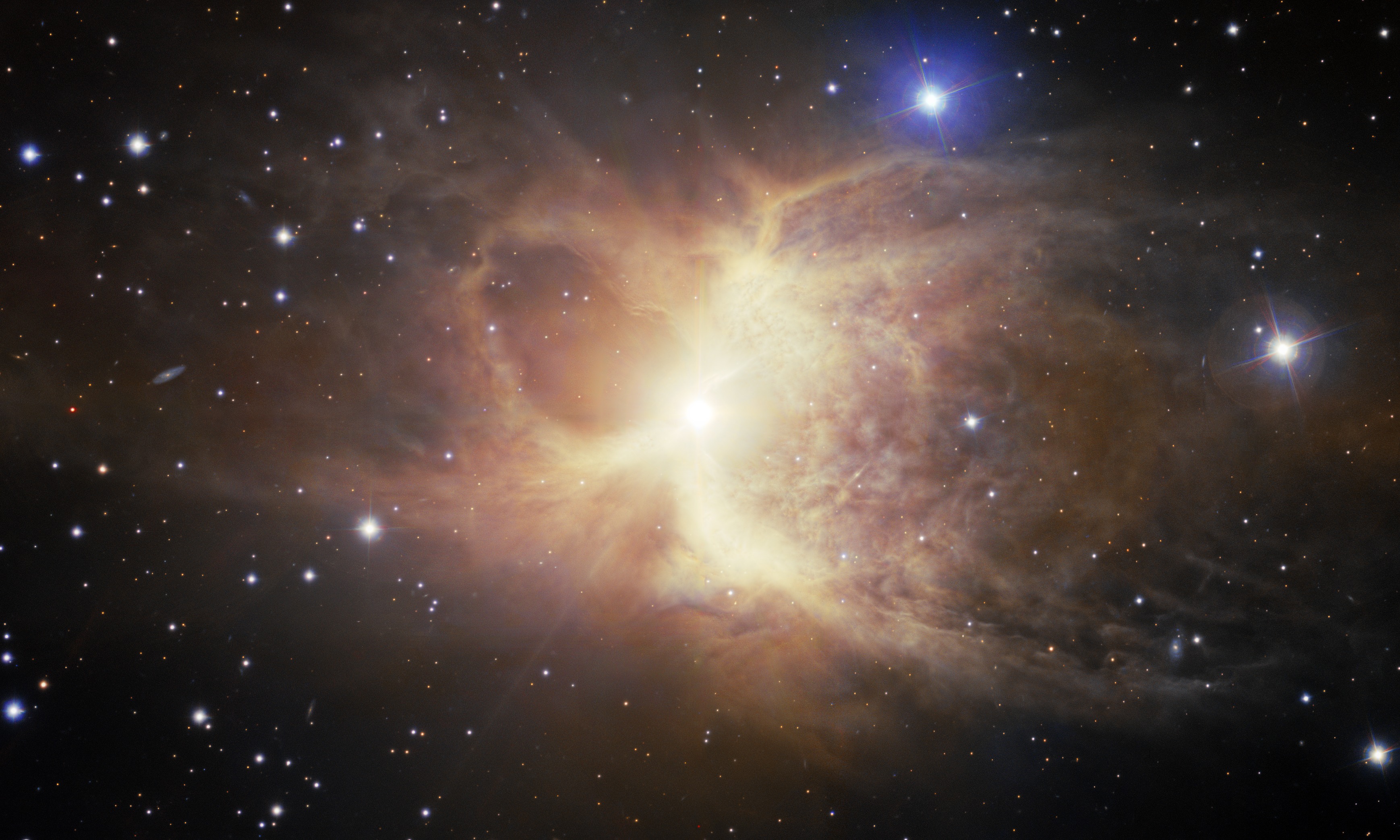Con la poderosa Cámara de Energía Oscura (DECam por sus siglas en inglés) de 570 megapíxeles, fabricada por el Departamento de Energía de Estados Unidos, los astrónomos han construido una imagen gigante de 1,3 gigapíxeles que muestra la parte central del remanente de Supernova Vela, un cadáver cósmico de una gigantesca estrella que explotó como una supernova. DECam es uno de los instrumentos de imágenes de campo amplio más productivos del mundo y está montada en el Telescopio de 4 metros Víctor M. Blanco de la Fundación Nacional de Ciencias de EE.UU en el Observatorio Interamericano Cerro Tololo en Chile, un Programa de NOIRLab de NSF.
Tag: NSF’s NOIRLab
Ghostly Stellar Tendrils Captured in Largest DECam Image Ever Released
With the powerful, 570-megapixel Department of Energy-fabricated Dark Energy Camera (DECam), astronomers have constructed a massive 1.3-gigapixel image showcasing the central part of the Vela Supernova Remnant, the cosmic corpse of a gigantic star that exploded as a supernova.
El Observatorio Rubin impulsará una nueva era en misiones espaciales sin salir de la tierra
El Observatorio Vera C. Rubin ayudará a los científicos a identificar objetivos intrigantes para dar prioridad a futuras misiones espaciales, mediante la detección de millones de nuevos objetos en el Sistema Solar y revelar, con el mayor detalle jamás visto, el contexto más amplio en el que existen.
Rubin Observatory will Inspire a New Era in Space Missions without Ever Leaving the Ground
Vera C. Rubin Observatory will help scientists identify intriguing targets to prioritize for future space missions by detecting millions of new Solar System objects, and by revealing — in more detail than we’ve ever seen — the broader context in which these objects exist.
Journey Through the Universe celebra 20 años de exploración en la isla de Hawai‘i
Journey Through the Universe: una asociación entre el Observatorio Internacional Gemini, operado por NOIRLab de NSF, y el Departamento de Educación Hilo-Waiākea Complex Area de Hawaiʻi celebra 20 años de exploración cósmica con los estudiantes y la comunidad de Hawai‘i.
Journey Through the Universe Celebrates 20 Years of Exploration on Hawai‘i Island
Journey Through the Universe — a partnership between the International Gemini Observatory, operated by NSF’s NOIRLab, and the Hawaiʻi Department of Education Hilo-Waiākea Complex Area — celebrates 20 years of cosmic exploration with Hawai‘i students and the community.
El nacimiento de un monstruo magnético
Un equipo de investigadores, que incluía al astrónomo de NOIRLab André-Nicolas Chené, descubrió una inusual estrella con el campo magnético más poderoso jamás encontrado en una estrella masiva, que podría convertirla en uno de los objetos más magnéticos de todo el Universo, es decir, una variante de una estrella de neutrones conocida como “magnétar”. El hallazgo marca el descubrimiento de un nuevo tipo de objeto astronómico, una estrella de helio magnética masiva, y provee información sobre el origen de los magnétares.
Astronomers Find Progenitor of Magnetic Monster
A team of researchers, including NOIRLab astronomer André-Nicolas Chené, has found a highly unusual star that has the most powerful magnetic field ever found in a massive star — and that may become one of the most magnetic objects in the Universe: a variant of a neutron star known as a magnetar. This finding marks the discovery of a new type of astronomical object — a massive magnetic helium star — and sheds light on the origin of magnetars.

Cerro Tololo descubre galaxias en un tira y afloja cósmico, antes de fusionarse completamente
La galaxia espiral NGC 1532, también conocida como Haley’s Coronet, está atrapada en un tira y afloja desigual con su vecina más pequeña, NGC 1531. La imagen captura las influencias gravitacionales mutuas durante la fusión de una galaxia masiva y otra galaxia enana, y fue posible registrarla gracias a la Cámara de Energía Oscura, del Departamento de Energía de los Estados Unidos (DOE), que se encuentra montada en el Telescopio de 4 metros Víctor M. Blanco del Observatorio de Cerro Tololo un Programa que opera NOIRLab de NSF en Chile.

Una jarra cósmica desbordando material estelar
Una serie de nubes simétricas y ondulantes de polvo y gas marcan la agónica muerte de una antigua estrella gigante roja, tal como lo muestra esta imagen obtenida en Chile por el telescopio Gemini Sur, parte del Observatorio Internacional Gemini, operado por AURA y NOIRLab de NSF. La estructura resultante, que se dice se parece a una jarra inglesa de estilo antiguo, es una nebulosa de reflexión bipolar que rara vez es posible de apreciar. La evidencia sugiere que este objeto se formó por las interacciones entre la estrella gigante roja moribunda y una estrella compañera destrozada hace mucho.

Rare, Double-Lobe Nebula Resembles Overflowing Cosmic ‘Jug’
A billowing pair of nearly symmetrical loops of dust and gas mark the death throes of an ancient red-giant star, as captured by Gemini South, one half of the International Gemini Observatory, operated by NSF’s NOIRLab. The resulting structure, said to resemble an old style of English jug, is a rarely seen bipolar reflection nebula. Evidence suggests that this object formed by the interactions between the dying red giant and a now-shredded companion star.
Gemini North Detects Multiple Rock-Forming Elements in the Atmosphere of a Scorching Exoplanet
Astronomers using the Gemini North telescope, one half of the International Gemini Observatory operated by NSF’s NOIRLab, have detected multiple rock-forming elements in the atmosphere of a Jupiter-sized exoplanet, WASP-76b. The planet is so perilously close to its host star that rock-forming elements — such as magnesium, calcium, and nickel — become vaporized and dispersed throughout its scorching atmosphere. This intriguing chemical profile provides new insights into the formation of planetary systems, including our own.
Gemini Norte detecta múltiples elementos que forman rocas en la atmósfera de un exoplaneta sumido en el infierno
Utilizando el telescopio de Gemini Norte, la mitad boreal del Observatorio Internacional Gemini, que opera NOIRLab de NSF y AURA, un equipo de astrónomos detectó diversos elementos formadores de rocas en la atmósfera de un exoplaneta del tamaño de Júpiter llamado WASP-76b. El planeta está tan peligrosamente cerca de su estrella que los elementos formadores de rocas, como el magnesio, calcio y níquel, se evaporan y se dispersan por toda su abrasadora atmósfera. Este intrigante perfil químico provee nuevos conocimientos sobre la formación de sistemas planetarios, incluido el nuestro.
Estudio registra casi dos millones de galaxias, cuásares y estrellas en su publicación preliminar
Casi dos millones de objetos, que incluyen galaxias distantes, cuásares y estrellas, se encuentran en la publicación preliminar de datos del Instrumento Espectroscópico de Energía Oscura (DESI), del Laboratorio Nacional Lawrence Berkeley, en el Observatorio Nacional de Kitt Peak, un Programa de NOIRLab de NSF. Estos datos ayudarán a los investigadores a estudiar la historia de la expansión del Universo con un detalle sin precedentes y explorar otras áreas de la investigación astrofísica de frontera. DESI es financiado por el Departamento de Energía de los Estados Unidos y administrado por el Laboratorio Berkeley.

Rubin Observatory Brings a Universe of Discovery to the Public
The Vera C. Rubin Observatory Education and Public Outreach program launches today, marking the first time that a major next-generation astronomy research facility has integrated a comprehensive and fully NSF-funded outreach program into its construction phase. When it begins science operations in late 2024, Rubin will produce a complete survey of the southern sky every few nights to study dark matter, dark energy, and the changing Universe. Rubin will share this adventure with the public.
Rings of Quaoar
A recent stellar occultation has revealed the presence of a second ring around the dwarf planet candidate Quaoar. Using the ‘Alopeke instrument on the Gemini North telescope in Hawai‘i operated by NSF’s NOIRLab, astronomers detected tiny fluctuations in the star’s light, indicating the presence of a ring that exists at a rather unusual location in Quaoar’s orbit.
Un criadero estelar de luces y sombras
Un instante de la enorme nube interestelar de formación de estrellas Lupus 3, capturado por la Cámara de Energía Oscura de 570-megapíxeles desde el Observatorio de Cerro Tololo de NOIRLab, en Chile. La brillante región central de esta nube en expansión revela un par de jóvenes estrellas brotando desde sus capullos de polvo y gas para iluminar la nebulosa de reflexión conocida como Bernes 149. El contraste de luces entre estas regiones hacen de este objeto uno de los principales lugares para la investigación sobre formación estelar.
Radiant Protostars and Shadowy Clouds Clash in Stellar Nursery
The massive, star-forming interstellar cloud Lupus 3 is captured with the 570-megapixel US Department of Energy-fabricated Dark Energy Camera at NSF’s NOIRLab’s Cerro Tololo Inter-American Observatory in Chile. The dazzling central region of this sprawling cloud reveals a pair of infant stars bursting from their natal cocoons of dust and gas to illuminate the reflection nebula known as Bernes 149. These contrasting regions make this object a prime target of research on star formation.
Científicos logran mejorar la nitidez de la primera imagen de un agujero negro
Un equipo de científicos, que incluyó a un astrónomo de NOIRLab de NSF, desarrolló una nueva técnica de aprendizaje automático (machine-learning) para mejorar la definición y la nitidez de imágenes de interferometría de radio. Para demostrar el poder de su nueva técnica, a la que llamaron PRIMO, el equipo creó una nueva versión, en alta definición, de la icónica imagen captada por el Telescopio Event Horizon del agujero negro supermasivo ubicado al centro de Messier 87, una galaxia elíptica gigante localizada a unos 55 millones de años luz de la Tierra.
Dark Sky Protection: We Are Losing the Universe
White LEDs contributing to skyglow, satellites impacting astronomical observations, and stars vanishing from sight — the effects of light pollution are revealed thanks to alarming new evidence from Globe at Night, a global citizen science program of NSF’s NOIRLab. The study reveals that indeed the night sky is disappearing, but there is always something we can do. On 13 March 2023, Globe at Night will begin its next campaign, which will last until 22 March and coincides with the launch of a new Globe at Night website that features a revamped and more streamlined user interface.
Journey Through the Universe Returns to Hilo Classes
Journey Through the Universe — a partnership among NSF’s NOIRLab/Gemini, the Hawaiʻi Department of Education Hilo-Waiākea Complex Area, and the TMT International Observatory — returns to its in-person format to share with Hawai‘i students the wonders of the Universe and awareness of careers in science and technology. This year’s exciting program includes classroom presentations, career panels, a teacher workshop and more!
Unveiling Networks of Stellar Nurseries in Nearby Galaxies
Janice Lee, Chief Scientist at the International Gemini Observatory, leads the JWST Treasury Survey for the PHANGS (Physics at High Angular resolution in Nearby Galaxies) collaboration to study how star formation affects the evolution of galaxies. These observations are providing new insights into how some of the smallest-scale processes in our Universe — the beginnings of star formation — impact the evolution of the largest objects in our cosmos: galaxies.